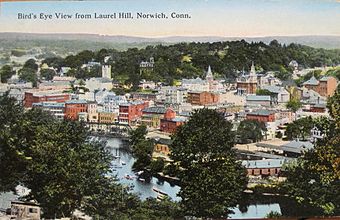Laurel Hill Historic District facts for kids
Quick facts for kids |
|
|
Laurel Hill Historic District
|
|
 |
|
| Location | Roughly bounded by Spruce Street, Rogers and River Avenues, and Talman Street, Norwich, Connecticut |
|---|---|
| Area | 120 acres (49 ha) |
| Architect | Bill, Henry |
| Architectural style | Late Victorian, Italianate, Folk Victorian |
| NRHP reference No. | 87000516 |
| Added to NRHP | October 26, 1987 |
The Laurel Hill Historic District is a special neighborhood in Norwich, Connecticut. It's known for its many old homes, mostly built in the 1800s. This area was added to the National Register of Historic Places in 1987 because of its important history and beautiful buildings. It stretches south from the Shetucket River and includes streets like Laurel Hill Avenue and Spruce Street.
Contents
Discovering Laurel Hill's History
Where is Laurel Hill?
Laurel Hill is located just south of downtown Norwich. The Shetucket River separates it from the city center. This neighborhood is built on hillsides, making it a unique place to explore. Laurel Hill Avenue is the main road, running parallel to the Thames River. Other streets like Spruce Street and River Avenue also follow the hillside.
What Kinds of Buildings Are Here?
The historic district has 124 houses and one old factory building. Almost all of these buildings were built in the 1800s. About one-third of the houses are in the Italianate style. This style was popular in the 1850s and 1860s. You can also see homes built in the Carpenter Gothic and Queen Anne Victorian styles.
The only important non-house building is an old schoolhouse from around 1871. It is also built in the Italianate style and is one of only two brick buildings in the district. The other brick building is a house. The district also includes Laurel Hill Park, which was part of the original plan for the area.
How Laurel Hill Began
Before 1850, the Laurel Hill area was mostly empty land. This was because the hills made it hard to build there. In 1850, a group of developers, led by a man named Henry Bill, bought most of the land. They created Laurel Hill Avenue and started telling people it was a great place to live. They wanted it to be a country-style suburban area, like what Andrew Jackson Downing suggested.
The first homes built near the Shetucket River were large and had beautiful gardens. Henry Bill even built his own home overlooking the river to show how nice the area was. He also pushed for a free bridge to be built across the river.
The neighborhood grew a lot during and after the American Civil War. This was a time when businesses were doing very well. Many high-quality homes were built during this period. However, the building lots became smaller further south in the neighborhood. Some buildings were also built for more than one family to live in.






